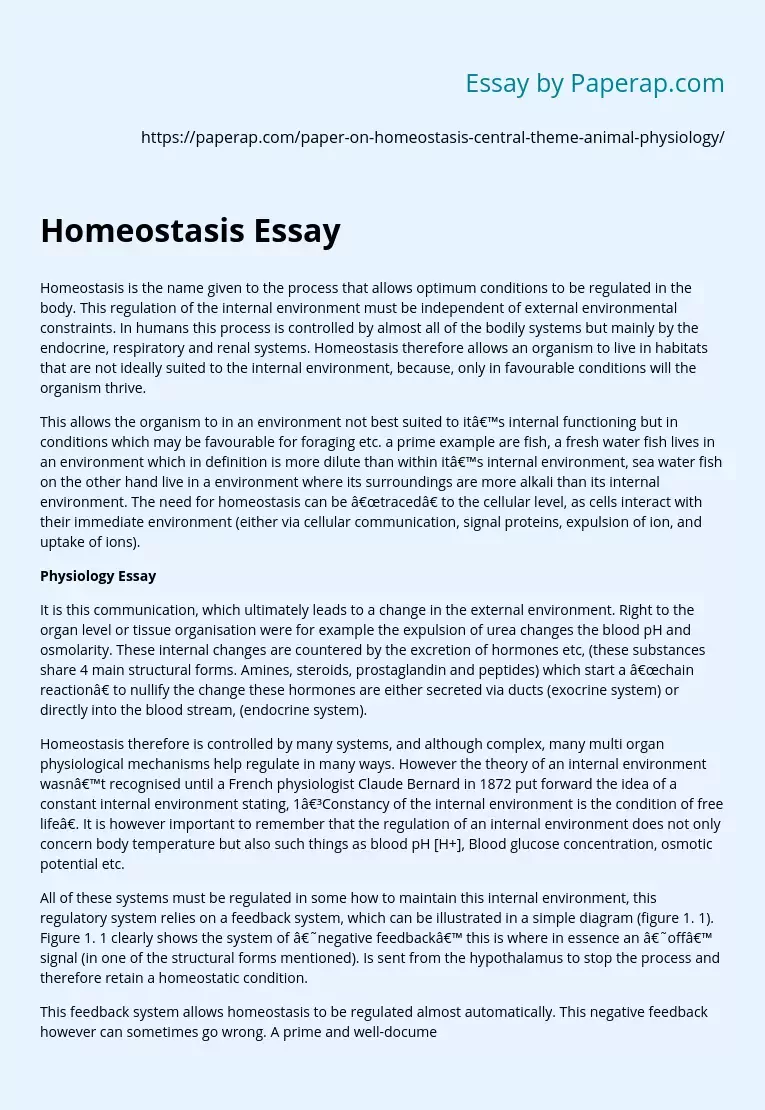Homeostasis Essay
Homeostasis is the name given to the process that allows optimum conditions to be regulated in the body. This regulation of the internal environment must be independent of external environmental constraints. In humans this process is controlled by almost all of the bodily systems but mainly by the endocrine, respiratory and renal systems. Homeostasis therefore allows an organism to live in habitats that are not ideally suited to the internal environment, because, only in favourable conditions will the organism thrive.
This allows the organism to in an environment not best suited to it’s internal functioning but in conditions which may be favourable for foraging etc.
a prime example are fish, a fresh water fish lives in an environment which in definition is more dilute than within it’s internal environment, sea water fish on the other hand live in a environment where its surroundings are more alkali than its internal environment. The need for homeostasis can be “traced” to the cellular level, as cells interact with their immediate environment (either via cellular communication, signal proteins, expulsion of ion, and uptake of ions).
Physiology Essay
It is this communication, which ultimately leads to a change in the external environment. Right to the organ level or tissue organisation were for example the expulsion of urea changes the blood pH and osmolarity. These internal changes are countered by the excretion of hormones etc, (these substances share 4 main structural forms. Amines, steroids, prostaglandin and peptides) which start a “chain reaction” to nullify the change these hormones are either secreted via ducts (exocrine system) or directly into the blood stream, (endocrine system).
Homeostasis therefore is controlled by many systems, and although complex, many multi organ physiological mechanisms help regulate in many ways. However the theory of an internal environment wasn’t recognised until a French physiologist Claude Bernard in 1872 put forward the idea of a constant internal environment stating, 1″Constancy of the internal environment is the condition of free life”. It is however important to remember that the regulation of an internal environment does not only concern body temperature but also such things as blood pH [H+], Blood glucose concentration, osmotic potential etc.
All of these systems must be regulated in some how to maintain this internal environment, this regulatory system relies on a feedback system, which can be illustrated in a simple diagram (figure 1. 1). Figure 1. 1 clearly shows the system of ‘negative feedback’ this is where in essence an ‘off’ signal (in one of the structural forms mentioned). Is sent from the hypothalamus to stop the process and therefore retain a homeostatic condition.
This feedback system allows homeostasis to be regulated almost automatically. This negative feedback however can sometimes go wrong. A prime and well-documented case of this is diabetes. When blood glucose levels increase above a ‘threshold limit’ the endocrine system (stimulated via the hypothalamus) activates the pancreas, this then secretes a hormone called insulin which this accelerates the uptake of blood glucose into storage molecules of glycogen (especially in the liver) and fat molecules.
However if this uptake of sugar is not regulated enough then absorption of sugar will continue and the blood glucose level drop’s the result is glaucoma and ultimately death. This leads to the conclusion that glaucoma is the result of a breakdown in the homeostatic system and therefore a breakdown of blood glucose regulation. Homeostasis however is not only controlled by the hypothalamus, hormones which are produced by the hypothalamus to regulate homeostasis, are regulated by neurohormones, which are secreted by specialised nerve cells called neurosecretory cells.
These cells which are found in the hypothalamus. These regulate the secretion of various glandular hormones from the non-neural anterior pituitary gland. These neurohormones are different to the hormones secreted by the hypothalamus as they target direct tissues (with relation to hormone structure and function). These specific neurosecretory cells are located in the anterior hypothalamus, these also demonstrate the diversity found within an organ, which allows this process to be self regulated.
But homeostasis is not only regulated by internal bodily systems but also external structural/environmental conditions, an example environmental control is that of heat transference, As all metabolic reactions produce heat sometimes this heat would build up in the body, this would have devastating consequences on bodily functions such as the functioning of enzymes as after a certain temperature these become permanently de natured and unable to function, So when the body over heats, the hypothalamus sends a signal to the sweat glands which are located in the epidermal layer of the skin to produce sweat.
This sweat then evaporates taking the heat energy with it. Therefore reducing the body temperature and maintaining homeostasis, the skeletal structure is an example of a structural way of controlling homeostasis. This is mainly due to the composition of skeletal bone. As skeletal bone is comprised mainly of calcium this can act as a calcium reserve. there are times in the homeostatic cycle when this calcium needs to be metabolised from bone tissue for use by other systems, e. . Calcium is very important for normal muscle functioning, therefore calcium ion concentration must be kept at a correct level in the surrounding blood and tissue fluids, the consequences of a breakdown in this regulation would lead to changes in the calcium ion concentration leading to a compromise in muscle activity, it is in this way that the skeletal system helps regulate homeostasis.
The conclusion of this is that homeostasis is essential to a living organism and is in essence self regulated by a complex system of feedback loops regulated by many organ systems however these regulatory systems sometimes go wrong and need external assistance be this injecting hormones, taking advantage of environmental conditions, i. e. basking in the sun (lizards), panting (dogs, etc).
Homeostasis Essay. (2019, Dec 05). Retrieved from https://paperap.com/paper-on-homeostasis-central-theme-animal-physiology/

